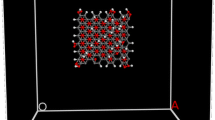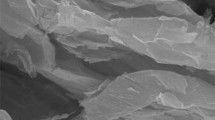Abstract
Graphene is a promising additive for lubricants. The rheological properties of graphene nanofluids have a significant impact on the tribological performance of base oil. In this case, rheological properties including viscosity, density, mean square displacement and diffusion coefficient of graphene–PAO nanofluids were investigated by using the nonequilibrium molecular dynamics simulations in order to understand the effects of graphene on the rheological properties of base oil under extreme conditions. The molecular dynamics model was validated according to the experimental and numerical statistics reported by other researchers. The simulation results reflected that the viscosity of base oil was effectively improved by adding graphene nanoparticles. As the concentration of graphene increased, the viscosity of nanofluids becomes higher. However, the diffusion coefficient reached its highest value (3.73 × 10−9 m2/s) with nanofluids containing two pieces of graphene in the system. Furthermore, we found that the graphene played a more significant role in enhancing the viscosity of base oil at high temperature and pressure. The viscosity was especially improved by 290.2% at 0.1 MPa, 500 K. The boiling point of the base oil became higher than 800 K after adding graphene. To our best knowledge, this work is the first study of the rheological properties of graphene–PAO nanofluids using molecular dynamic simulations.






Similar content being viewed by others
References
Johnson B, Wu HX, Desanker M, Pickens D, Chung YW, Wang QJ (2018) Direct formation of lubricious and wear protective carbon films from phosphorus and sulfur free oil soluble additives. Tribol Lett 66:2
Bashirnezhad K, Bazri S, Safaei MR, Goodarzi M, Dahar M, Mahian O, Dalkılıça AS, Wongwises S (2016) Viscosity of nanofluids: a review of recent experimental studies. Int Commun Heat Mass 73:114–123
Etemadi H, Shojaei A, Jahanmard P (2014) Effect of alumina nanoparticle on tribological performance of automotive brake friction materials. J Reinf Plast Compos 33:166–178
Aralihalli S, Biswas SK (2013) Grafting of dispersants on MoS2 in base oil lubrication of steel. Tribol Lett 49:61–76
Aldana PU, Dassenoy F, Vacher B, Mogne TL, Thiebaut B (2016) WS2 nanoparticles anti-wear and friction reducing properties on rough surfaces in the presence of ZDDP additive. Tribol Int 102:213–221
Sharma V, Timmons R, Erdemir A, Aswath PB (2017) Plasma-functionalized polytetrafluoroethylene nanoparticles for improved wear in lubricated contact. ACS Appl Mater Interfaces 9:25631–25641
Wu LP, Gu L, Xie ZJ, Zhang CW, Song BY (2017) Improved tribological properties of Si3N4/GCr15 sliding pairs with few layer graphene as oil additives. Ceram Int 43:14218–14224
Berman D, Erdemir A, Sumant AV (2014) Graphene: a new emerging lubricant. Mater Today 17:31–42
Yang CZ, Hou X, Li ZW, Li XH, Yu LG, Zhang ZJ (2016) Preparation of surface-modified lanthanum fluoride–graphene oxide nanohybrids and evaluation of their tribological properties as lubricant additive in liquid paraffin. Appl Surf Sci 43:497–502
Yu B, Liu ZL, Zhou F, Liu WM, Liang YM (2008) A novel lubricant additive based on carbon nanotubes for ionic liquids. Mater Lett 62:2967–2969
Zhang ZN, Liu J, Wu TH, Xie YB (2017) Effect of carbon nanotubes on friction and wear of a piston ring and cylinder liner system under dry and lubricated conditions. Friction 5:147–154
Murshed SMS, Estelle P (2017) A state of the art review on viscosity of nanofluids. Renew Sustain Energy Rev 76:1134–1152
Sharma AK, Tiwari AK, Dixit AR (2016) Rheological behavior of nanofluids: a review. Renew Sustain Energy Rev 53:779–791
Kole M, Dey TK (2013) Investigation of thermal conductivity, viscosity and electrical conductivity of graphene based nanofluids. J Appl Phys 113:084307
Moghaddam MB, Goharshadi EK, Entezari MH, Nancarrow P (2013) Preparation, characterization, and rheological properties of graphene–glycerol nanofluids. Chem Eng J 231:365–372
Ahammed N, Asirvatham LG, Wongwises S (2016) Effect of volume concentration and temperature on viscosity and surface tension of graphene–water nanofluid for heat transfer applications. J Therm Anal Calorim 123:1399–1409
Tesfai W, Singh P, Shatilla Y, Iqbal MZ, Abdala A (2013) Rheology and microstructure of dilute graphene oxide suspension. Int J Nanoparticle Res 15:1989
Meharali M, Sadeghinezhad E, Latibari ST, Mehrali M, Togun H, Zubir MNM, Kazi SN, Metselaar HSC (2014) Preparation, characterization, viscosity, and thermal conductivity of nitrogen-doped graphene aqueous nanofluids. J Mater Sci 49:7156–7171. https://doi.org/10.1007/s10853-014-8424-8
Mehrali M, Sadeghinezhad E, Latibari ST, Kazi SN, Mehrali M, Zubir MNM, Metselaar HSC (2014) Investigation of thermal conductivity and rheological properties of nanofluids containing graphene nanoplatelets. Nanoscale Res Lett 9:15
Meyer N, Xu H, Wax JF (2016) Temperature and density dependence of the shear viscosity of liquid sodium. Phys Rev B 93:214203
Lou ZY, Yang ML (2015) Molecular dynamics simulations on the shear viscosity of Al2O3 nanofluids. Comput Fluids 117:17–23
Loya A, Ren GG (2015) Molecular dynamics simulation study of rheological properties of CuO–water nanofluid. J Mater Sci 50:4075–4082. https://doi.org/10.1007/s10853-015-8963-7
Liu PZ, Lu J, Yu HL, Ren N, Lockwood FE, Wang QJ (2017) Lubricant shear thinning behavior correlated with variation of radius of gyration via molecular dynamics simulations. J Chem Phys 147:084904
Moghaddam MB, Goharshadi EK, Moosavi F (2016) Structural and transport properties and solubility parameter of graphene/glycerol nanofluids: a molecular dynamics simulation study. J Mol Liq 222:82–87
Hess B (2002) Determining the shear viscosity of model liquids from molecular dynamics simulations. J Chem Phys 116:209–217
Plimpton S (1995) Fast parallel algorithms for short-range molecular dynamics. J Comput Phys 117:1–19
Alder BJ, Gass DM, Wainwright TE (1970) Studies in molecular dynamics. VIII. The transport coefficients for a hard-sphere fluid. J Chem Phys 53:3813–3826
Kubo R (1957) Statistical-mechanical theory of irreversible processes. I. General theory and simple applications to magnetic and conduction problems. J Phys Soc Jpn 12:570–586
Bair B (2002) The high pressure rheology of some simple model hydrocarbons. Proc Inst Mech Eng J J Eng Tribol 216:139–149
Liu PZ, Yu HL, Ren N, Lockwood FE, Wang QJ (2015) Pressure-viscosity coefficient of hydrocarbon base oil through molecular dynamics simulations. Tribol Lett 60:34–43
Rashin MN, Hemalatha J (2013) Viscosity studies on novel copper oxide–coconut oil nanofluid. Exp Thermal Fluid Sci 48:67–72
Rashin MN, Hemalatha J (2013) Synthesis and viscosity studies of novel ecofriendly ZnO–coconut oil nanofluid. Exp Thermal Fluid Sci 51:312–318
Acknowledgements
This work was supported by the Natural Science Foundation of China (Grant No. U1737204) and the Foundation for Innovative Research Groups of the National Natural Science Foundation of China (Grant No. 51521003). Lupeng Wu would like to thank financial support from China Scholarship Council (CSC, No. 201706120143). In particular, Lupeng Wu would like to thank his true love—Lina Wu—for her great support.
Author information
Authors and Affiliations
Corresponding author
Ethics declarations
Conflict of interest
All authors declare that they have no conflict of interest.
Rights and permissions
About this article
Cite this article
Wu, L., Keer, L.M., Lu, J. et al. Molecular dynamics simulations of the rheological properties of graphene–PAO nanofluids. J Mater Sci 53, 15969–15976 (2018). https://doi.org/10.1007/s10853-018-2756-8
Received:
Accepted:
Published:
Issue Date:
DOI: https://doi.org/10.1007/s10853-018-2756-8




